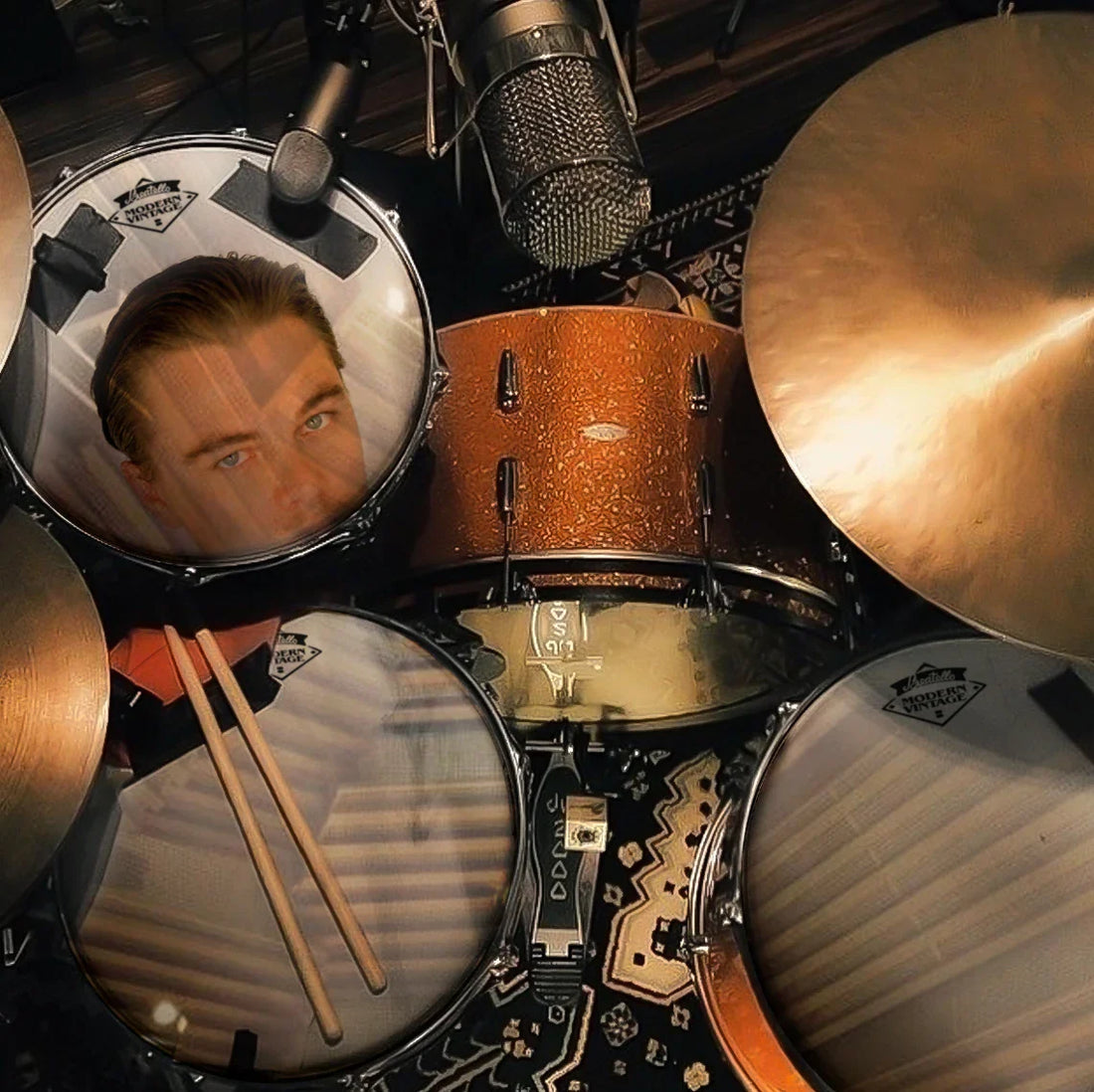The Secret to Your Sound: How to Clean Drumheads
Every nuance of your drumming depends on the quality and condition of your drumheads. But over time, they gather dirt, stick marks, and grime. This buildup can make your drums sound dull, affect their durability, and frankly, just look unprofessional.
Want to keep your kit sounding and looking its best? Regular cleaning is key! Here's a simple guide to get your drumheads sparkling and singing again.

Your drumheads are the beating heart of your drum's sound. They're the thin membranes that vibrate when struck, producing everything from sharp snare cracks to booming bass drum thumps. Every nuance of your drumming depends on the quality and condition of your drumheads. But over time, they gather dirt, stick marks, and grime. This buildup can make your drums sound dull, affect their durability, and frankly, just look unprofessional.
Want to keep your kit sounding and looking its best? Regular cleaning is key! Here's a simple guide to get your drumheads sparkling and singing again.
How to Clean Drumheads
Your drumheads are the beating heart of your drum's sound. They're the thin membranes that vibrate when struck, producing everything from sharp snare cracks to booming bass drum thumps. Every nuance of your drumming depends on the quality and condition of your drumheads. But over time, they gather dirt, stick marks, and grime. This buildup can make your drums sound dull, affect their durability, and frankly, just look unprofessional.
Want to keep your kit sounding and looking its best? Regular cleaning is key! Here's a simple guide to get your drumheads sparkling and singing again.
What You'll Need
Before you start, gather these simple items:
- A soft, clean microfiber cloth or a non-abrasive sponge.
- Mild dish soap (just a few drops) or a specialized drum cleaner.
- Warm water.
- A separate dry cloth for drying.(Optional for stubborn marks on coated heads) A magic eraser (melamine foam) – use with extreme caution!
Step-by-Step Drumhead Cleaning Guide
Follow these steps for a gentle yet effective clean:
-
Remove Heads (Recommended for Best Results): For the most thorough clean, especially for your batter (top) heads, it's best to take them off the drum. This lets you clean the entire surface without worrying about getting water on your drum shell's hardware or wood. If you're just doing a quick surface wipe, you can leave them on.
-
Dust It Off: Start by gently wiping away any loose dust, lint, or debris with a dry microfiber cloth.
-
Mix Your Solution: In a small bowl, add a few drops of mild dish soap to warm water. You want a very diluted solution – too much soap can leave a sticky residue.
-
Dampen Your Cloth: Dip your microfiber cloth into the soapy water and wring it out very, very well. The cloth should be just damp, not dripping wet. Excess water can easily get trapped in the hoop channel or potentially damage wood shells.
-
Gentle Wipe Down:
For Clear Heads: Gently wipe the entire surface of the drumhead in circular motions. You'll often see stick marks disappear easily -
Tackle Stubborn Marks (Coated Heads – Use with Extreme Caution!): For really tough stick marks on coated heads, you can very carefully try a damp magic eraser. Lightly wet the magic eraser and gently rub only the stick mark. Do NOT scrub hard or rub excessively, as this will remove the coating. Always test a small, inconspicuous area first if you're unsure.
-
Rinse (If Needed): If you used more than a minimal amount of soap, dampen a clean cloth with plain water (again, wrung out very well) and gently wipe down the head to remove any soap residue.
-
Dry Thoroughly: This step is crucial! Immediately use a clean, dry cloth to completely dry the entire drumhead surface. Make sure absolutely no moisture is left behind, especially if the head is still on the drum.
-
Reinstall & Tune (If Removed): Once your drumheads are completely dry, reinstall them if you took them off and tune them back to your desired pitch.
How to Clean Drumheads
Your drumheads are the beating heart of your drum's sound. They're the thin membranes that vibrate when struck, producing everything from sharp snare cracks to booming bass drum thumps. Every nuance of your drumming depends on the quality and condition of your drumheads. But over time, they gather dirt, stick marks, and grime. This buildup can make your drums sound dull, affect their durability, and frankly, just look unprofessional.
Want to keep your kit sounding and looking its best? Regular cleaning is key! Here's a simple guide to get your drumheads sparkling and singing again.
What You'll Need
Before you start, gather these simple items:
A soft, clean microfiber cloth or a non-abrasive sponge.
Mild dish soap (just a few drops) or a specialized drum cleaner.
Warm water.
A separate dry cloth for drying.(Optional for stubborn marks on coated heads) A magic eraser (melamine foam) – use with extreme caution!
Step-by-Step Drumhead Cleaning Guide
Follow these steps for a gentle yet effective clean:
-
Remove Heads (Recommended for Best Results): For the most thorough clean, especially for your batter (top) heads, it's best to take them off the drum. This lets you clean the entire surface without worrying about getting water on your drum shell's hardware or wood. If you're just doing a quick surface wipe, you can leave them on.
-
Dust It Off: Start by gently wiping away any loose dust, lint, or debris with a dry microfiber cloth.
-
Mix Your Solution: In a small bowl, add a few drops of mild dish soap to warm water. You want a very diluted solution – too much soap can leave a sticky residue.
-
Dampen Your Cloth: Dip your microfiber cloth into the soapy water and wring it out very, very well. The cloth should be just damp, not dripping wet. Excess water can easily get trapped in the hoop channel or potentially damage wood shells.
-
Gentle Wipe Down:
For Clear Heads: Gently wipe the entire surface of the drumhead in circular motions. You'll often see stick marks disappear easily.
For Coated Heads: Be extra careful here, as the coating can be delicate. Wipe lightly to avoid rubbing it off. Focus on stick marks and noticeably dirty areas. If marks are stubborn, you can try a very light scrub.
-
Tackle Stubborn Marks (Coated Heads – Use with Extreme Caution!): For really tough stick marks on coated heads, you can very carefully try a damp magic eraser. Lightly wet the magic eraser and gently rub only the stick mark. Do NOT scrub hard or rub excessively, as this will remove the coating. Always test a small, inconspicuous area first if you're unsure.
-
Rinse (If Needed): If you used more than a minimal amount of soap, dampen a clean cloth with plain water (again, wrung out very well) and gently wipe down the head to remove any soap residue.
-
Dry Thoroughly: This step is crucial! Immediately use a clean, dry cloth to completely dry the entire drumhead surface. Make sure absolutely no moisture is left behind, especially if the head is still on the drum.
-
Reinstall & Tune (If Removed): Once your drumheads are completely dry, reinstall them if you took them off and tune them back to your desired pitch.
Important Tips for Drumhead Care
No Harsh Chemicals: Never use abrasive cleaners, strong solvents, or anything containing alcohol. These can permanently damage the Mylar film or strip off any coating.
Be Gentle with Coated Heads: The coating gives you that warm sound and brush texture, but it's not invincible. Excessive scrubbing will wear it away.
Regular Maintenance is Key: A quick wipe-down after each extended practice session or gig can prevent heavy buildup, making deeper cleans less frequent and extending the life of your heads.
Don't Forget Resonant Heads: While you don't hit them directly, the bottom (resonant) heads also collect dust and grime. Clean them occasionally to ensure optimal resonance and sound.
By giving your drumheads a little regular love and care, you'll ensure your kit always sounds its best, performs reliably, and looks sharp. Now get back to making some noise!
